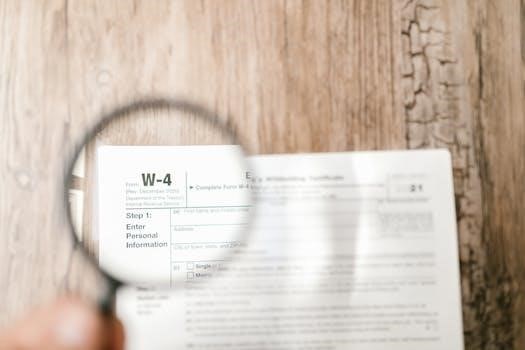NFPA 72 Inspection Form PDF⁚ A Comprehensive Guide
This comprehensive guide explores the essential aspects of the NFPA 72 inspection form PDF. It will cover the importance of regular fire alarm system inspections, ensuring compliance, and maintaining optimal system functionality. This guide aims to provide detailed insights into the process.
NFPA 72, the National Fire Alarm and Signaling Code, sets the standard for fire alarm systems. These systems safeguard lives and property through early detection and alerts. Regular inspections, documented using NFPA 72 inspection forms, are crucial for ensuring these systems operate effectively. The inspection forms, often available as PDFs, serve as checklists to verify component functionality, proper installation, and adherence to code requirements. Proper execution of these forms, including system wiring checks and completion records, guarantees the fire alarm system’s reliability. Consistent inspection using NFPA 72 guidelines is vital for maintaining fire safety.
Understanding NFPA 72 Requirements
Understanding NFPA 72 requirements is crucial for proper fire alarm system inspection. Compliance ensures the system functions effectively during emergencies. This section will outline the key aspects of NFPA 72 relevant to inspections.
Key Sections of NFPA 72 Relevant to Inspections
NFPA 72 encompasses numerous sections, but certain chapters are crucial for effective inspections. Chapter 14 details inspection, testing, and maintenance procedures vital for ensuring system reliability. Sections on documentation, record keeping, and the proper execution of inspection forms are very important. Requirements for initiating devices such as smoke detectors, heat detectors, and pull stations are contained within. Understanding the audibility requirements for notification appliances ensures alarms can be heard throughout the building. Power supply requirements and battery testing procedures are vital for sustained operation during emergencies. Lastly, knowing the requirements for emergency communication systems is essential.

Components of an NFPA 72 Inspection Form
The NFPA 72 inspection form includes sections for property information, fire alarm control panel assessment, and device checks. It also covers alarm system supervision type, testing procedures, and documentation of deficiencies identified during inspection.
Gathering essential information such as the property address, contact details, and previous inspection reports is crucial before initiating the NFPA 72 inspection. Familiarizing oneself with NFPA 72 requirements ensures compliance during the inspection process. The form includes key elements such as checking the accessibility and proper functioning of fire alarm control panels and detection devices. Accurate record-keeping of property details, including building name and address, is necessary. Identification of the monitoring station and documentation of any system deficiencies are vital for effective follow-up and corrective actions. Ensuring all sections are accurately completed helps maintain comprehensive records.
The NFPA 72 Inspection Checklist
The NFPA 72 inspection checklist offers a structured approach to fire alarm system inspections. It ensures that all critical components are thoroughly examined. This checklist is essential for comprehensive assessments and compliance.
Detailed Checklist Items for Fire Alarm System Inspections
A detailed NFPA 72 inspection checklist includes verifying proper labeling of rooms and equipment, ensuring accessible fire alarm control panels, and assessing detector functionality. Checks on pull stations, smoke detectors, heat detectors, and water flow are critical. The checklist also involves confirming system wiring inspections, reviewing supervisory contracts, and validating agency certifications. Battery tests, charger assessments, and voltage checks are essential. Emergency communication systems and monitoring station functionality should also be verified. The checklist ensures comprehensive system performance and compliance with NFPA 72 standards, promoting fire safety.
Pre-Inspection Preparations
Before conducting an NFPA 72 inspection, gather necessary information such as property address, inspection date, and contact details. Familiarize yourself with NFPA 72 requirements to ensure comprehensive compliance during the assessment process.
Gathering Necessary Information and Documents
Essential Elements and Information Gathering
Prior to initiating an NFPA 72 inspection, gathering essential documentation is crucial. This includes having access to project plans, approved shop drawings, and the system operation matrix. Ensure you have the final NFPA 72 Fire Alarm System Record of Completion readily available. Furthermore, collect listing and approval agency certificates. Verify the system’s supervisory monitoring contract agreement is accessible. Having these documents on hand streamlines the inspection process and ensures thorough compliance verification. Efficient preparation minimizes delays and supports accurate assessment of the fire alarm system’s integrity and performance.
Conducting the NFPA 72 Inspection
Performing an NFPA 72 inspection requires a systematic approach. This involves verifying the system’s components, functionality, and adherence to code. Following a step-by-step guide ensures thoroughness and accuracy during the inspection.
Step-by-Step Guide to Performing the Inspection
Begin by gathering necessary information, like the property address and inspection date. Then, review past inspection reports. Proceed to visually inspect the fire alarm control panel, ensuring accessibility and proper functioning. Check initiating devices like smoke and heat detectors for clear visibility and operational status. Verify notification appliances such as horns and strobes are unobstructed and functioning correctly. Test the system’s response to alarm signals, confirming proper communication with the monitoring station. Document all findings meticulously on the NFPA 72 inspection form, noting any deficiencies and corrective actions taken. Finally, ensure proper execution of the form.

Functional Testing Procedures
Functional testing involves activating fire alarm system components to ensure proper operation. This includes testing smoke detectors, pull stations, and notification appliances, all while documenting the results on the NFPA 72 inspection form.
Testing Fire Alarm System Components
The process of testing fire alarm system components is crucial for verifying their operational status and compliance with NFPA 72 standards. This involves a systematic approach to evaluate each component’s functionality, ensuring they respond as intended during a fire emergency. Testing procedures include activating manual pull stations to confirm alarm transmission, introducing simulated smoke to detectors for response time assessment, and verifying audible and visual notification devices’ effectiveness. Furthermore, monitoring the fire alarm control panel for accurate signal processing and verifying the system’s communication with the monitoring station are essential steps. Proper documentation of these tests on the NFPA 72 inspection form is vital.
Documentation and Record Keeping
Accurate documentation and meticulous record-keeping are paramount for NFPA 72 compliance. Properly filling out the inspection form ensures a comprehensive history of the system. This supports future inspections, maintenance, and liability considerations, enhancing overall fire safety.
Properly Executing the NFPA 72 Inspection Form
Properly executing the NFPA 72 inspection form is crucial for maintaining accurate records and ensuring fire safety compliance. Begin by gathering necessary property information, including the address and contact details. Carefully review the checklist items, verifying each component of the fire alarm system. Document all findings, noting any deficiencies or areas requiring attention. Ensure that all sections of the form are completed accurately and legibly. Sign and date the form upon completion, providing a clear record of the inspection. Store completed forms securely for future reference and audits, adhering to NFPA 72 guidelines for documentation.
Common NFPA 72 Inspection Deficiencies
Identifying common NFPA 72 inspection deficiencies is vital for maintaining system integrity. This section will outline frequent issues found during inspections. Addressing these proactively ensures better fire safety and compliance with NFPA standards.
Identifying and Addressing Common Issues
During NFPA 72 inspections, several deficiencies frequently arise. These include malfunctioning smoke detectors, issues with fire alarm control panels, and inadequate battery backups. Addressing these problems promptly is crucial for ensuring the fire alarm system operates effectively during an emergency. Proper documentation and systematic troubleshooting are essential steps in resolving these deficiencies. Furthermore, it is important to ensure that all repairs and maintenance work are performed by qualified technicians. Regular inspections and timely corrections will minimize risks and maintain compliance with NFPA standards, safeguarding lives and property from potential fire hazards. Proper maintenance also extends the lifespan of the system.

NFPA 72 Record of Completion
The NFPA 72 Record of Completion is a critical document. It confirms that a fire alarm system meets the required standards. Accurate completion ensures system reliability and compliance with safety regulations. It should be properly executed.
Importance and Proper Execution
The NFPA 72 Record of Completion serves as official verification that the fire alarm system adheres to all specified codes and standards. Proper execution of this form is paramount for ensuring the system’s integrity and reliability. A correctly filled form demonstrates due diligence. It also supports compliance with legal and insurance requirements. Include detailed system information. Verify all testing results. Signatures from qualified personnel are essential. This provides a clear audit trail. Accurate documentation ensures quick reference during future inspections and maintenance. Ultimately, a properly executed record enhances safety and minimizes potential risks associated with fire incidents.

Resources for NFPA 72 Compliance and Inspection Forms
This section provides access to valuable resources. These resources include NFPA 72 documents, inspection form PDF templates, and compliance tools. These resources will help to ensure accurate fire alarm system inspections.
Where to Find NFPA 72 Inspection Form PDF Templates
Finding the right NFPA 72 inspection form PDF template is crucial for compliance and accurate record-keeping. Several online sources offer these templates. Reputable fire safety equipment suppliers often provide downloadable forms. Also, industry-specific websites and professional organizations dedicated to fire safety may offer templates.
Government agencies and regulatory bodies sometimes provide access to standardized inspection forms. Ensure the template aligns with the latest NFPA 72 edition. Verify its compatibility with local and state regulations. Using a reliable template ensures comprehensive inspections and facilitates clear documentation of findings for compliance.

